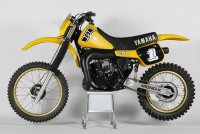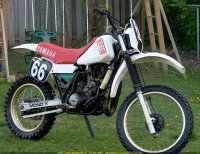You are using an out of date browser. It may not display this or other websites correctly.
You should upgrade or use an alternative browser.
You should upgrade or use an alternative browser.
Running 84 yz 250 plus parts bikes (Southern Indiana)
- Thread starter Tom
- Start date
evomx244
PR Addict
starting to make progress on my 82-frame back from powder coating, taking crank and cylinder to bore tech in the next week. Just gathering up pieces slowly. Luckly greasing the linkage everyweek in 82 paid off as the bearings are in great shape!
Attachments
MarctheSharc
PR Founding Father
Yeah, that's one of the coolest builds I know of.
Keep us in the loop.
Keep us in the loop.
evomx244
PR Addict
Scott you must build another wood stand like in the pic and take it back to the same place on the concrete at dirt country for another picture. It would be like time travel
That's funny because I raced at Dirt Country over the summer and parked pretty close to the same place. That same thought popped in my head to Chris! I'll make it happen
Update the cylinder made it over to Bore Tech yesterday
k01
PR Elite
Is there a better example of a bike in transition than the '82 YZ 250? A water cooled decent motor but the radiator isn't where it belongs. A linkage system that's appears to still be part monoshock. Monoshock type swept back bars and mounts that really look exaggerated with that radiator out front, giving the bike it's unique appearance and stance. A strong front drum brake and an excellent tank/seat transition with comfortable layout for a bike that is way too heavy. And the '82 is vastly different from the year before and after.
Git-r-done evo! And tell us about Bore Tech. Isn't that the place with the engineer looking, pipe smoker ads?
Where has '82 guy Mike been during this discussion?
Git-r-done evo! And tell us about Bore Tech. Isn't that the place with the engineer looking, pipe smoker ads?
Where has '82 guy Mike been during this discussion?
evomx244
PR Addict
Is there a better example of a bike in transition than the '82 YZ 250? A water cooled decent motor but the radiator isn't where it belongs. A linkage system that's appears to still be part monoshock. Monoshock type swept back bars and mounts that really look exaggerated with that radiator out front, giving the bike it's unique appearance and stance. A strong front drum brake and an excellent tank/seat transition with comfortable layout for a bike that is way too heavy. And the '82 is vastly different from the year before and after.
Git-r-done evo! And tell us about Bore Tech. Isn't that the place with the engineer looking, pipe smoker ads?
Where has '82 guy Mike been during this discussion?
Yes you are correct about the Ad, Bill does great work.
Mike is no longer a 82 YZ guy as he bought my 84 YZ250 right after Mid-Ohio last year
NQ1965
PR Elite
NQ1965
PR Elite
BIKES THAT CHANGED MOTOCROSS
------------------------------------
http://www.pulpmx.com/stories/bikes-changed-motocross
1982 Yamaha YZ250
Behold the first truly modern motocross bike, the 1982 YZ250. The 82 YZ was the first motocross bike to put together in one bike the key technologies that would shape motocross performance for the next 2 decades. History has largely forgotten this machine. In 82 it was a mediocre performing bike at best. Because of this, people overlook it as the breakthrough bike that it was. For starters it was overweight and underpowered. Add to that a top-heavy feel, bulky ergonomics, and merely passible suspension performance. With all that in mind it is little wonder this bike has slipped into obscurity. Dig a little deeper though and you will discover a bike that planted the seeds for the amazing bikes we ride today. In 1982 this bike was on the very bleeding edge of Moto technology. Features we take for granted today like safety seats and power valves all debuted on this machine. The 1982 YZ250 was the first appearance of the modern two-stroke engine as we know it today.
This bike was less than the sum of its parts

The 82 YZ250 and YZ125 were the first production motocross bikes to feature a variable exhaust port. Yamaha called this little bit of techno wizardry YPVS which stood for Yamaha Power Valve System. The YPVS consisted of a small cylinder above the exhaust port that would rotate based on engine RPM. As the YPVS cylinder rotated, it would raise or lower the height of the exhaust port, changing the power characteristics of the motor. Before the introduction of systems like the YPVS, engine tuners had to set up their power plants for either low-end power or top end thrust. With the advent of technologies like the YPVS the motor could in theory be made to do both. The 82 YZ250 was also Yamaha’s first use of liquid cooling on a 250cc MX bike. Now of course all motocross bikes are liquid cooled, but in the early 80’s there was still a great debate going on about the merits of it. Many people believed the added weight and complexity of liquid cooling a 250cc bike far outweighed the benefit of sustained power over the course of a race.
Team Yamaha in fact, actually went back to an air cooled bike to race in the 82 Supercross series. The major problem with the liquid cooling on this bike was the horrible design of it. Yamaha bolted the radiator to the triple clamps and then routed the hoses through the steering head. As a result the YZ carried a great deal of weight very high on the bike. This poor design lead to poor handling and leaks over time. Like most of this bike’s forward thinking technology, it was an excellent idea poorly implemented.
The third piece of major technology debuting on this bike was Yamaha’s first use of a rising rate linkage rear suspension. Yamaha had pioneered the single shock suspension system back in 1975 with their Monoshock but by 1981 they had fallen behind designs like Suzuki’s Full Floater system. To combat this, Yamaha introduced an all new Mono-X suspension system on the 82 YZ’s. It was a much simpler system than Suzuki’s Full Floater but the performance was not nearly as good. The 82 YZ250 was a very advanced bike that fell well short of its promise. Even so it paved the way for the many great motocross bikes that followed in its footsteps. Take a look at the brand new 2012 KTM 250SX and you will still see many of the features pioneered on this bike.
It's like two, two engines in one!

------------------------------------
http://www.pulpmx.com/stories/bikes-changed-motocross
1982 Yamaha YZ250
Behold the first truly modern motocross bike, the 1982 YZ250. The 82 YZ was the first motocross bike to put together in one bike the key technologies that would shape motocross performance for the next 2 decades. History has largely forgotten this machine. In 82 it was a mediocre performing bike at best. Because of this, people overlook it as the breakthrough bike that it was. For starters it was overweight and underpowered. Add to that a top-heavy feel, bulky ergonomics, and merely passible suspension performance. With all that in mind it is little wonder this bike has slipped into obscurity. Dig a little deeper though and you will discover a bike that planted the seeds for the amazing bikes we ride today. In 1982 this bike was on the very bleeding edge of Moto technology. Features we take for granted today like safety seats and power valves all debuted on this machine. The 1982 YZ250 was the first appearance of the modern two-stroke engine as we know it today.
This bike was less than the sum of its parts

The 82 YZ250 and YZ125 were the first production motocross bikes to feature a variable exhaust port. Yamaha called this little bit of techno wizardry YPVS which stood for Yamaha Power Valve System. The YPVS consisted of a small cylinder above the exhaust port that would rotate based on engine RPM. As the YPVS cylinder rotated, it would raise or lower the height of the exhaust port, changing the power characteristics of the motor. Before the introduction of systems like the YPVS, engine tuners had to set up their power plants for either low-end power or top end thrust. With the advent of technologies like the YPVS the motor could in theory be made to do both. The 82 YZ250 was also Yamaha’s first use of liquid cooling on a 250cc MX bike. Now of course all motocross bikes are liquid cooled, but in the early 80’s there was still a great debate going on about the merits of it. Many people believed the added weight and complexity of liquid cooling a 250cc bike far outweighed the benefit of sustained power over the course of a race.
Team Yamaha in fact, actually went back to an air cooled bike to race in the 82 Supercross series. The major problem with the liquid cooling on this bike was the horrible design of it. Yamaha bolted the radiator to the triple clamps and then routed the hoses through the steering head. As a result the YZ carried a great deal of weight very high on the bike. This poor design lead to poor handling and leaks over time. Like most of this bike’s forward thinking technology, it was an excellent idea poorly implemented.
The third piece of major technology debuting on this bike was Yamaha’s first use of a rising rate linkage rear suspension. Yamaha had pioneered the single shock suspension system back in 1975 with their Monoshock but by 1981 they had fallen behind designs like Suzuki’s Full Floater system. To combat this, Yamaha introduced an all new Mono-X suspension system on the 82 YZ’s. It was a much simpler system than Suzuki’s Full Floater but the performance was not nearly as good. The 82 YZ250 was a very advanced bike that fell well short of its promise. Even so it paved the way for the many great motocross bikes that followed in its footsteps. Take a look at the brand new 2012 KTM 250SX and you will still see many of the features pioneered on this bike.
It's like two, two engines in one!

NQ1965
PR Elite
Of all the bikes I've owned and ran, they've all had, (or have), their own particular engine sound. But for some reason my 82 YZ has always had the most unique. (probably wiped out engine bearings , hee hee  )
)
It's always had the same sensation of the old 4 barrel carb 60& 70's muscle cars when you roll on the throttle. First you hear the change in pitch of the engine and then the thrust. And it has always felt like it always had a little more horsepower or torque if I needed it. Just crank'r some more and hold on.
The first time my son saddled it for a spin, he commented afterward that the engine felt just like he was on my 2003 YZ.
It's always had the same sensation of the old 4 barrel carb 60& 70's muscle cars when you roll on the throttle. First you hear the change in pitch of the engine and then the thrust. And it has always felt like it always had a little more horsepower or torque if I needed it. Just crank'r some more and hold on.
The first time my son saddled it for a spin, he commented afterward that the engine felt just like he was on my 2003 YZ.











